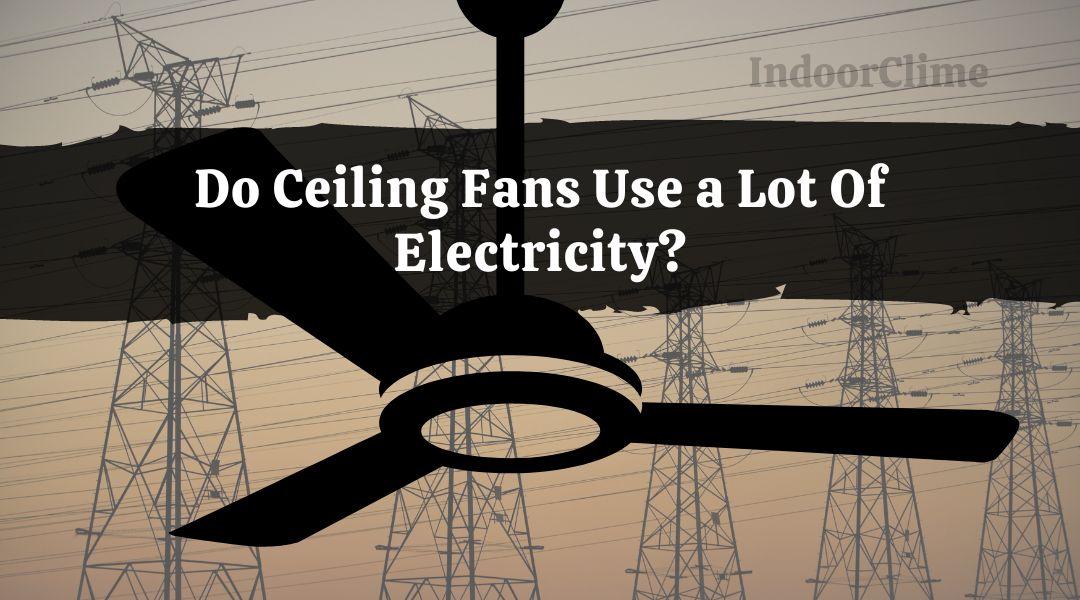Ceiling fans are great for keeping heat away from homes, especially during summer. In addition, ceiling fans can help circulate air in a room, which helps cool it down. In the winter, ceiling fans can help circulate warm air that rises to the top of a room.
However, should you worry about your upcoming bills when using these for your home or office spaces?
Ceiling fans only use a lot of electricity only if they are outdated. Older ceiling fans usually consume between 60 to 100 watts of power, while new ones use only 15 to 30 watts.
Updating your ceiling fans can save a lot on your electricity bill.
If you’re still over the fence about whether ceiling fans are better options, this article will cover ceiling fan electricity coverage and how much they cost.
How Much Electricity Does a Ceiling Fan Use?

Using ceiling fans for homes and offices provides many benefits. But how much does it cost to use a ceiling fan?
The average ceiling fan will use about 75 watts of power; if you have an older model, it could use as much as 100 watts. The good news is that newer models use significantly less energy, with some only using about 15 to 30 watts.
So, how much does it cost to run a ceiling fan? If you’re paying $0.10 per kilowatt-hour of electricity, running a newer model ceiling fan would cost you about $0.008 per hour. It would cost you about $0.012 per hour for an older model.
In most cases, the cost of running a ceiling fan is negligible. If you’re only using it for a few hours daily, you’re probably not seeing a significant increase in your electricity bill.
However, a few factors could cause your ceiling fan to use more electricity. If you’re using many of them or running them for long periods, you may see a slight increase in your bill.
How Much Does It Cost To Run a Ceiling Fan 24/7?

Running a ceiling fan could get costly if they’re running for a prolonged time. So, how much would it cost to run a ceiling fan 24/7?
If you’re paying $0.10 per kilowatt-hour of electricity and your ceiling fan uses 75 watts of power, it would cost you about $0.60 per day or $18.00 per month to keep it running all day and night.
But this is just an estimate. The actual cost of electricity use may still depend on how long you use your appliances and the cost of electricity in your area.
While ceiling fans are most commonly used in the summer to keep cool. A ceiling fan helps circulate warm air within the space during winter, thus lessening heating costs.
Your ceiling fan should be running in the reverse direction in the winter, and it will push the warm air that rises to the ceiling back down into the room.
Running your ceiling fan in the winter will not use a lot of electricity, but it could help you save on your heating costs. A typical heater system will usually cost around $0.12 per hour. But with a ceiling fan, you can save significant money.
Do Ceiling Fans Use A Lot Of Electricity?

Ceiling fans don’t use much electricity and are one of the most efficient ways to cool your home. And if you’re using them in the winter, they can help you save money on your heating costs.
You can lower your ceiling fan usage by opening doors and windows during the cooler hours of the day to let in the fresh air.
Install ceiling fans where it’s needed. Aside from unnecessary expenses, using these only in spaces where people congregate will also make it more effective in cooling or heating the areas. Ensure the ceiling is at least eight feet high to ensure maximum benefit.
Also, avoid using huge ceiling fans as they can create too much wind chill and be noisy. Ask a professional to find your space’s best ceiling fan size.
So, ceiling fans are a great option if you want to save money on your energy bills. Just get a new, energy-efficient model to maximize your savings.
How To Reduce The Cost Of Running A Ceiling Fan?

You can reduce electricity costs and reduce ceiling fan use in several ways.
Keep the blinds close to keep the sun’s heat away from the room. It can make a space feel up to 10 degrees cooler.
Open doors and windows during the cooler hours of the day to let in the fresh air.
The wrong fan direction could make (or break) your electricity budget. Set the fan counter-clockwise during summer to bring a refreshing breeze.
Run the ceiling fan clockwise in winter to help push the warm air near the ceiling back into the room.
Traditional ceiling fan blades are usually flat, making them less efficient. Instead, opt for newer models with tilted blades to help move more air. You can also find energy-efficient models that use less electricity.
Compared to air conditioners, ceiling fans only circulate air inside the room. In cases where you need to use an air conditioning unit, you can use the fan as a supplement to help reduce the energy your air conditioner uses.
Another way to reduce the cost of running a ceiling fan is to use it only when needed. If you’re not in the room, there’s no need to keep the fan on.
Keep the blades of your ceiling fan clean to ensure proper air circulation. Dust and dirt buildup can make the blades less effective in moving air.
Avoid using colossal ceiling fans as they can create too much wind chill and be noisy.
Asking a professional for appropriate ceiling fan models for your space would greatly help. In addition, HVAC technicians can help you find an energy-efficient ceiling fan that would greatly help save on electricity costs.
Doing all these could help save on electricity costs, not only for ceiling fans but the entire household.
Ceiling Fans vs. Air Conditioners | Which Is Cheaper & More Energy-Efficient?

Ceiling fans are cheaper and more energy-efficient than air conditioners. While an air conditioner can cost around $0.12 per hour, a ceiling fan only costs approximately $0.026 per hour.
In terms of saving energy, ceiling fans use less energy than air conditioners. This is because air conditioners work by cooling the air and removing humidity. On the other hand, ceiling fans only circulate the air in the room.
Ceiling fans are also more versatile than air conditioners. You can use these appliances for both summer and winter. In summer, they can help cool a room down. But in winter, using a fan circulates warm air within that space.
But keep in mind that ceiling fans only draw cool (or warm air) inside the room but never really cool it. There’s also a limit to its ability to circulate air. If a room is too big, a ceiling fan might not be efficient in this case.
Air conditioners are more powerful when cooling a room down and can lower temperatures by around 10-15 degrees Fahrenheit. But they are also more expensive to run and use more energy.
Depending on the model, you can taper down energy usage for these air conditioners by lowering the thermostat to 78 degrees Fahrenheit when you’re home and 82 degrees Fahrenheit when you’re away or asleep.
So, ceiling fans are a great option to save money on your energy bills. Just get a model with an ENERGY-star logo to maximize your savings.
People Also Ask
Are Ceiling Fans Energy-Efficient?
Yes, ceiling fans are more energy-efficient than air conditioners, requiring less energy to run for any season.
Which Is Better: A ceiling Fan Or a Standing Fan?
The answer to this question depends on your needs. If you’re looking for an energy-efficient option, ceiling fans are a better choice.
These appliances use less energy, so you don’t have to worry about skyrocketing bills at the end of the month. On the other hand, if you’re looking for a more powerful fan, a standing fan is a better option.
Also, consider the size of the room. If the room is too big, a ceiling fan might not be efficient in this case. In this instance, a standing fan would be a better option.
How Many Amps Does a Ceiling Fan Use?
The average ceiling fan uses around 1.5 to 3 amps. But this will vary depending on the model and make of the ceiling fan. To be sure, check the manufacturer’s specifications or ask a professional.
If you compare electricity costs between ceiling fans and lights, a ceiling fan would cost more to run. But this doesn’t mean that ceiling fans are expensive to run and cheaper than air conditioners.





